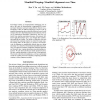Free Online Productivity Tools
i2Speak
i2Symbol
i2OCR
iTex2Img
iWeb2Print
iWeb2Shot
i2Type
iPdf2Split
iPdf2Merge
i2Bopomofo
i2Arabic
i2Style
i2Image
i2PDF
iLatex2Rtf
Sci2ools
109
click to vote
AAAI
2012
2012
Manifold Warping: Manifold Alignment over Time
Knowledge transfer is computationally challenging, due in part to the curse of dimensionality, compounded by source and target domains expressed using different features (e.g., documents written in different languages). Recent work on manifold learning has shown that data collected in real-world settings often have high-dimensional representations, but lie on low-dimensional manifolds. Furthermore, data sets collected from similar generating processes often present different high-dimensional views, even though their underlying manifolds are similar. The ability to align these data sets and extract this common structure is critical for many transfer learning tasks. In this paper, we present a novel framework for aligning two sequentially-ordered data sets, taking advantage of a shared low-dimensional manifold representation. Our approach combines traditional manifold alignment and dynamic time warping algorithms using alternating projections. We also show that the previously-proposed c...
Related Content
| Added | 29 Sep 2012 |
| Updated | 29 Sep 2012 |
| Type | Journal |
| Year | 2012 |
| Where | AAAI |
| Authors | Hoa Trong Vu, Clifton Carey, Sridhar Mahadevan |
Comments (0)

